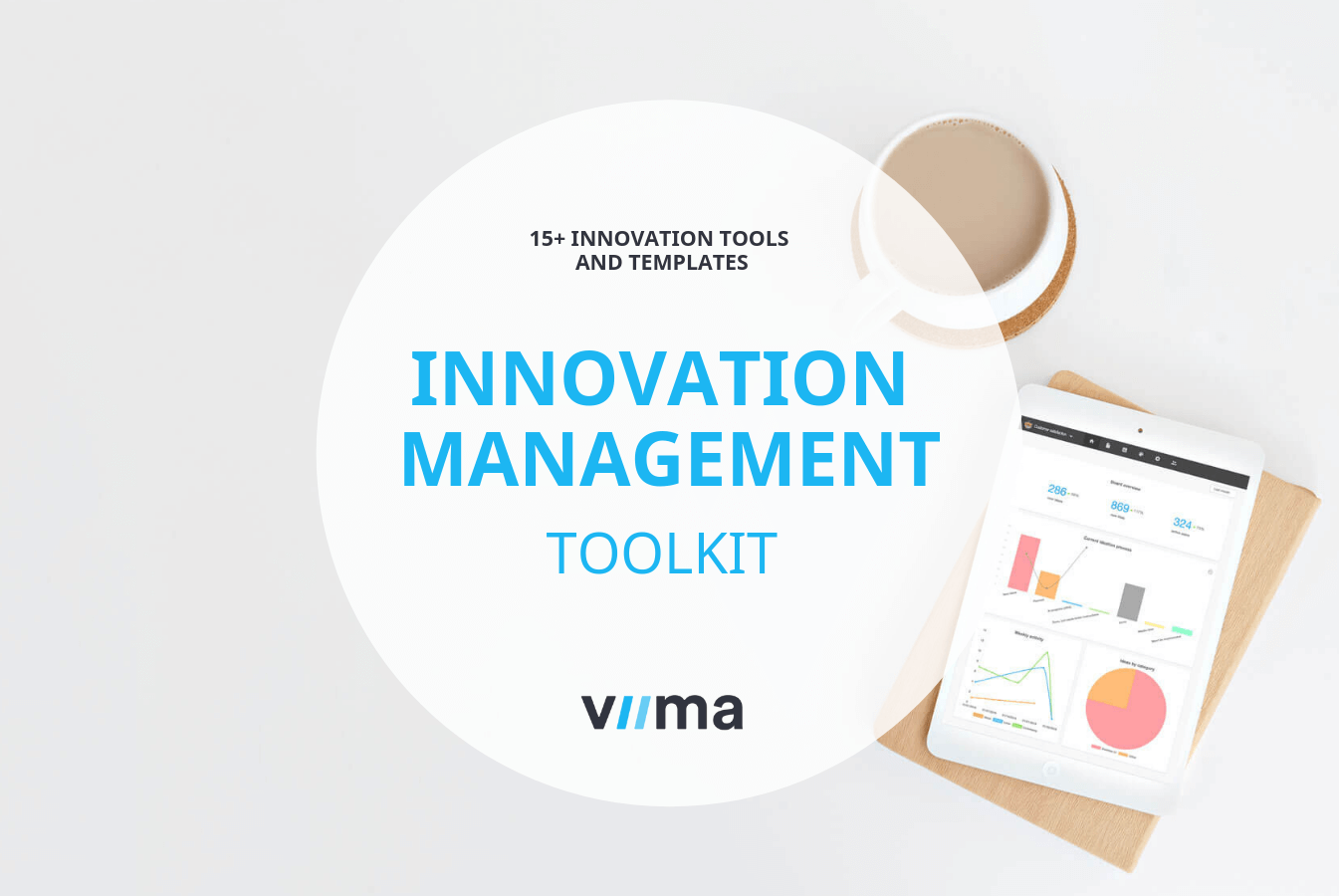The Ultimate Guide to Continuous Improvement
Continuous Improvement is one of those topics people often talk about and rarely have anything against, but that still doesn’t get the attention it deserves.
It’s like eating more vegetables: everyone knows it’s good for you, but most just don’t bother to really commit to doing it properly – for one reason or another.
In this article, we’ll first examine the concept in a bit more detail, and then provide practical tips, tools and best practices to help you drive tangible business results with continuous improvement.
Table of contents
What is Continuous Improvement?
The definition of continuous improvement is pretty simple: it’s simply an ongoing, in other word, continuous, effort to improve or make something better.
In business, this can mean a wide variety of things, including the products and services offered by an organization, as well as any and all processes they use, both internal and external.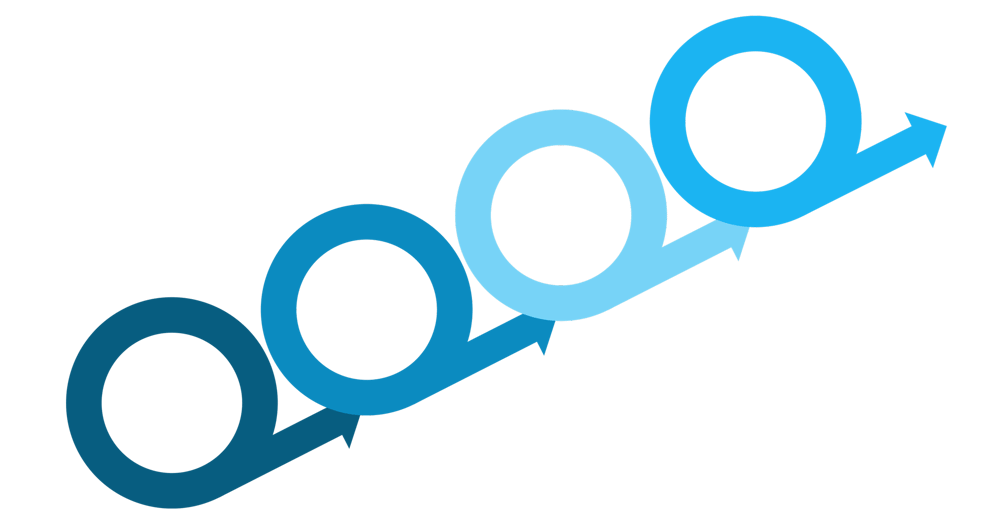 So, while on paper, this is very simple and something that every organization obviously does, there’s a bit more nuance that goes into the concept.
So, while on paper, this is very simple and something that every organization obviously does, there’s a bit more nuance that goes into the concept.
Continuous vs. Continual
One of the more debated parts of the concept is the use of the word “continuous”, versus “continual”, the latter of which is actually used by the official committee in charge of the ISO 9000 family of quality management systems.
So, what’s the difference?
“Continuous” as a term refers to something that happens all the time, for example on a daily basis. “Continual” on the other hand simply refers to something that’s on the agenda without being interrupted or paused, but there doesn’t necessarily have to be something going on all the time.
The reason the ISO committee decided to use the latter is because it is the more widely applicable term. Continuous improvement is always continual, but the reverse isn’t necessarily true.
Every organization, no matter how content they are with the current state, does some form of “continual improvement”, however, only the organizations that really take the topic seriously and are seeking to drive real results with it, are doing “continuous improvement”. Thus, I would argue that the ISO committee’s choice of words isn’t exactly ideal, and that’s why I will be using the term “continuous” in this article.
So, what continuous improvement really is, is a conscious, deliberate decision to continuously invest and focus on getting better, or in other words towards being more efficient and effective. It isn’t a one-off project with a start and an end, but an ongoing process that aims towards excellence in the chosen areas of focus.
Continuous improvement is a conscious, deliberate decision to continuously invest and focus on getting better. It isn’t a one-off project with a start and an end, but an ongoing process that aims towards excellence in the chosen areas of focus.
In our experience, companies that take continuous improvement seriously usually apply these principles to all key areas of their business operations and organization, instead of focusing just on some specific part of it. However, that isn’t necessarily always the case, and continuous improvement could also be applied to just one part, such as operations, sustainability, supply chain management, or cybersecurity.
Why is Continuous Improvement important?
Now that we understand what continuous improvement is, and what it isn’t, we can move onto the benefits of focusing on it.
We’ll start by listing some of the more specific things that can be achieved with solid continuous improvement processes and practices, and then move onto the more generally applicable benefits.
Benefits of doing continuous improvement
As mentioned, continuous improvement manifests itself in a variety of very tangible benefits that any organization would be happy to achieve. Some of the more common ones can be found below:
- Cost savings
- Less waste (time, resources, money)
- Increased operational efficiency
- Increased customer satisfaction
- Decreased capital requirements and inventory levels
- Improved sharing of knowledge and organizational learning
- Increased product/service quality
- Shorter feedback loop and time to value creation
- Improved culture and employee engagement
The first three are most obvious ones that everyone usually associates with continuous improvements. These naturally help the bottom line of an organization in a very meaningful way. Most leaders and managers do already understand the role that continuous improvement can play in these areas, so we won’t be going into more detail on them here.
However, in my opinion, the last three are actually the most interesting benefits for all of us who are interested in innovation and value creation.
So, the key is to understand that in addition to the bottom line, continuous improvement can also help to dramatically boost your top line results when applied properly.
In addition to improving your bottom line, continuous improvement can also help to dramatically boost your top line results.
In many ways, this kind of continuous improvement is much more important for your long-term success as an organization than the pure cost and efficiency improvements. These are, after all, the kind of improvements that keep creating value for your customers, and thus keep you relevant.
To give you some perspective on how these kinds of processes might work in practice, we’ll refer to one of our most successful customers, If P&C Insurance. As part of their strategy, they have a clear focus on customer satisfaction, and to achieve that goal, they set on a path to systematically find any potential frustrations or pain points customers may face, by engaging the people on the frontlines of the organization.
By systematically mapping out, prioritizing, and implementing as many of these ideas as possible throughout the years, the company has been able to significantly strengthen their position and become the clear market leader with excellent customer satisfaction, but also growth and financial performance.
The Big Picture & ROI of Continuous Improvement
So, let’s circle back to the big picture of why it pays off to invest into continuous improvement.
First, it's important to understand that it's nearly impossible to track the full ROI of continuous improvement. The reason for that is pretty simple: with good companies implementing thousands of improvements annually, most of which have many different kinds of benefits, some soft (time saved, improved quality and customers satisfaction etc.) and some hard ( saved money, decreased waste etc.), it's impossible to keep track of all of these no matter how hard you try to do that.
Because of this background, and of course the fact that there are many other variables in play, such as the company's industry, the extent to which continuous improvement is embraced, and so on, there are wildly different financial returns for continuous improvement. As a result, there isn't much in terms of credible research that would've been able to, or would've even tried to, quantify that accurately.
On the other hand, I've yet to hear anyone seriously argue that continuous improvement wouldn't be worth it for any company, or that it would lead to negative returns.
So, in the end, the big picture is pretty simple.
If you don’t systematically focus on improving the way you operate and do business, you’ll inevitably lose ground against your competitors little by little until you finally become obsolete. That’s the baseline in the chart below.
If you don't improve, you'll lose ground against your competitors little by little until you finally become obsolete. On the other hand, if you get a bit better every day, the results compound and lead to a profound difference over time.
But if you embrace continuous improvement, and apply it to every facet of your business, you’ll get a bit better every day, or at least week. But, what makes this truly interesting is that the results compound.
So, if you just keep doing that for a sustained period of time, the difference will be profound, and it will be incredibly difficult for the competition to catch you as long as you keep your foot on the figurative gas pedal.
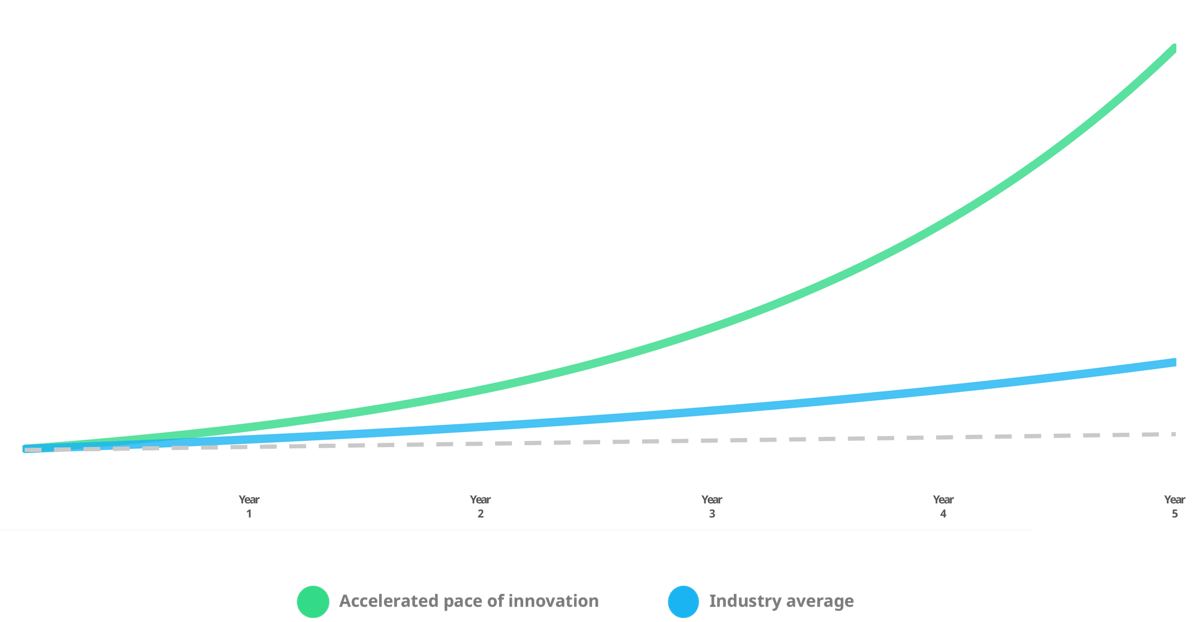 But that’s not all. Within our audience, which is largely comprised of innovators, I often see that people aren’t all that excited about these little improvements here and there. Many consider themselves to be visionaries, and thus find these little things to be mundane or boring, and not worthy of their time.
But that’s not all. Within our audience, which is largely comprised of innovators, I often see that people aren’t all that excited about these little improvements here and there. Many consider themselves to be visionaries, and thus find these little things to be mundane or boring, and not worthy of their time.
However, that is a big mistake. If you’ve ever really gone through the trouble of bringing an innovation to market, you know that there’s no such thing as overnight breakthrough success in innovation.
You can look at any real breakthrough, be it the light bulb, an electric car, or any of the stories I shared in that article above, and you’ll see that after the initial a-ha moment, there’s always years of hard work to get that idea to work, and to bring it to the world at scale. And how do you get that to work? Well, you continuously improve every facet of the innovation, and the methods via which you deliver it to market.
So, even if you claim to be an innovator that’s just focused on those big breakthrough innovations, you can’t argue the power of continuous improvement and the role it plays in determining whether you end up with a success story – or a failure.
Continuous Improvement Processes
Naturally the next question you probably then have is how you do bring that into practice.
Well, the first step is to identify an area where you want to start doing continuous improvement, for example customer satisfaction, and then put a process in place for pursuing that goal.
And that is a very important point: you need to have different continuous improvement processes in different parts of the organizations, and for achieving different goals, instead of just having one company-wide effort. The kind of process that makes sense, as well as the expertise needed to make smart decisions and the resources needed to implement those ideas will be very different in cybersecurity than they will be in sustainability or customer satisfaction.
With a single process, it’s very easy to start prioritizing the urgent over the important, especially in areas that the decision makers aren’t very familiar with and we see that happen all the time. So, don’t fall for the trap of thinking that one continuous improvement process is enough, it isn’t.
You need to have different continuous improvement processes in different parts of the organization, and for achieving different goals. Don’t fall for the trap of thinking that one process is enough, it isn’t.
With that out of the way, we can now move our focus towards what the actual processes look like. In reality, the exact steps and details, such as decision-makers and divisions of responsibilities, of the processes should always be determined on a case-by-case basis, but there are a number of commonly used process models or templates that you can use as the foundation for your specific process.
We unfortunately can’t cover all of them here for the sake of brevity, but we’ll give you an overview of the two most common ones. As mentioned, either of these will be a great starting point for anyone new to continuous improvement.
Kaizen Cycle
Kaizen is probably the most commonly referred concept related to continuous improvement. The term itself is loosely translated as good change or improvement, and in general it’s more of a philosophy than a specific process.
Kaizen is an intriguing concept to dive into in more detail, but for our purposes here, we’ll just focus on the Kaizen Cycle, which is the archetypal process for running Kaizen.
As the name would suggest, the Kaizen Cycle is cyclical by nature, just like every other continuous improvement process. It consists of seven different steps, which you can see from the image below.
For the most part, the steps are pretty self-explanatory: you engage people to find problems, identify the most relevant ones, come up with solutions, test them, analyze results, keep what works and roll those positive changes out at large, and then repeat the cycle.
However, the key to succeeding with the Kaizen Cycle comes from the famous adage: “Every day, everywhere, and by everybody”. If you are able to achieve that, you’ll do great.
The key to succeeding with Kaizen is to do it every day, everywhere, and by everybody.
So, it all starts by engaging people across the organization to identify problems or opportunities for improvement, and then also engaging them in the discussion towards finding potential solutions to these problems. It is, after all, the people on the frontlines of every organization that battle with these challenges every day, whereas management isn’t typically even aware of most of them, let alone realize how common or important a specific issue actually is.
Not only will this help you fix the right issues, but by engaging the entire organization in the process, you’ll be able to fight resistance to change and actually create a culture that values change, improvement, and innovation.
PDCA
PDCA, or the Deming Cycle as it’s often referred to, is probably the simplest and most commonly used framework for continuous improvement.
It has its roots way back in the 17th century and the scientific method but was popularized by W. Edwards Deming who is often referred to as the father of modern quality control. Since then, it’s become the cornerstone of a large numbers of the most common quality standards, such as those created by the International Standardization Organization (ISO).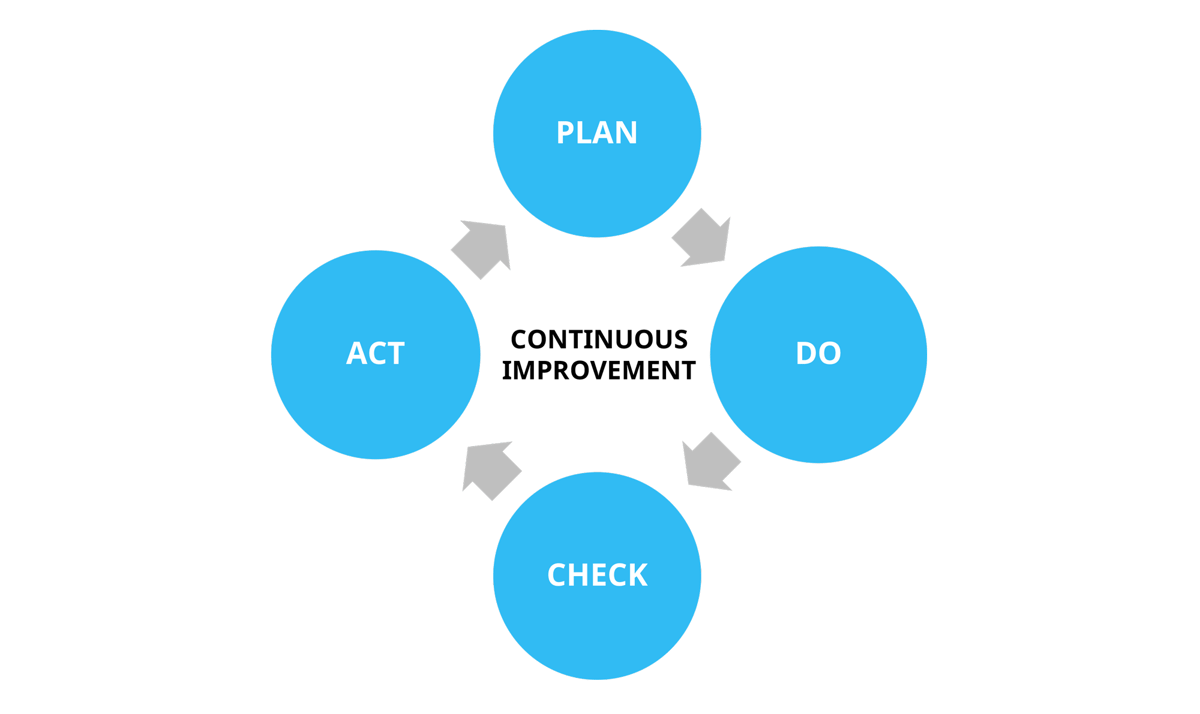 The acronym stands for Plan-Do-Check-Act, and the steps are again pretty self-explanatory. You start with a plan, then implement it, see if it worked and act accordingly.
The acronym stands for Plan-Do-Check-Act, and the steps are again pretty self-explanatory. You start with a plan, then implement it, see if it worked and act accordingly.
However, the real key with the PDCA method is to repeat this cycle as many times as necessary until the problem has been fixed or the goal has been achieved.
The purpose for doing this is that it’s often impossible to know all of the effects of a given change in advance, so it’s simply better to avoid analysis-paralysis and move forward quickly and then just keep improving as you learn more.
However, the big difference between the PDCA and the Kaizen Cycle is that the aforementioned is a bit simpler and more general, so it’s perhaps more widely applicable, but on the other hand, it doesn’t take the realities of most organizations into account as well as the Kaizen Cycle does.
So, for most forms of continuous improvement in organizations, the Kaizen Cycle would be my default recommendation.
Now, as an innovator, you might think that both of these iterative processes sound an awful lot like the lean startup method. Well, it does because both are based on the same exact principles that derive all the way from the scientific method, as discussed above.
So, in the end, the quality control and standardization people and innovators, who are often at odds with each other, still rely on nearly identical methods to achieve their different goals. Yet, what I personally find quite amusing is that even when both ends of the spectrum clearly are big supporters of iterative methods, many business leaders still think they can plan it all out in advance and just execute everything according to some kind of detailed masterplan without a hitch.
Continuous Improvement Tools and Methods
Now that we understand what the big picture of continuous improvements usually looks like, it’s time to dive deeper into the practicalities.
Having a process in place is all great, but you still need to make sure that progress actually happens in practice. So, what follows is a brief list of different kinds of tools, methods and practices that either we or our customers have found useful for supporting and enabling continuous improvement.
Kaizen Corner
The first and most commonly used method is a Kaizen Corner. It’s simply a place where employees can go to submit ideas and improvement suggestions. The term obviously comes from a time when the only way to do that was with a suggestion box at the corner of the break room. Since then, we’ve obviously made some technological progress, and a much easier and more practical way to do the same, especially in the times we’re now living in, is to use a software like Viima to accomplish the same job.
Since then, we’ve obviously made some technological progress, and a much easier and more practical way to do the same, especially in the times we’re now living in, is to use a software like Viima to accomplish the same job.
Regardless of the tool you use for the job, the key principles are the same:
- Employee leaves a suggestion. Ideally this would be via tool where it’s transparently visible to everyone, as this will improve communication and knowledge sharing.
- All suggestions must be reviewed and evaluated by management. This has a dual purpose: first of all, it creates a culture where employees know that their input is valued, and second, the employees will get feedback on WHY their idea was either approved or not approved, which further helps educate employees.
- On the back of our last point, Employees should be educated on how the process works, and trained on how they can better contribute. Remember to also tell why it is important for them to contribute.
- Implement as many feasible ideas as possible. As we’ve already discussed above, you don’t always know what the best ideas or solutions are in advance, and they might lead to new, even better ones down the road. And, more importantly, the benefits from each of these add up and compound over time. So, reserve sufficient resources for implementation and try to get as many of them done as possible.
- Reward employees for their contributions. This helps reinforce and sustain the effort, thus operationalizing it. We recommend rewarding successful and valuable ideas, but also for employees that show the right attitude and put in the effort, even if they would fail as this helps build the right kind of culture. While financial rewards can be a good idea, make sure to also use rewards that affect intrinsic motivation, such as praise and recognition in front of colleagues.
Kaizen Corner, and engaging employees in general, is an important cornerstone of any continuous improvement processes and should be a part of the toolbox for every company that's looking to do continuous improvement.
There's a widely cited figure floating around in the industry that 80% of all valid and useful improvement suggestions always come from employees on the frontlines. I haven't been able to find a source for these claims, but in our experience from working with hundreds of customers, this would seem to be at least proportionally correct.
80% of all valid and useful improvement suggestions come from employees on the frontlines of the company.
Gemba Walks
In Lean processes, regular Gemba Walks are one of the key methods managers should undertake.
The term originates from the Japanese word Genba, meaning “the actual place”. Thus, a Gemba walk simply means that management goes to the frontlines of the company where the work actually happens, be it the manufacturing floor or wherever customer service happens, walks around, observes how things are being done and asks questions. To be more specific, the idea is that these visits should be unscripted, and you shouldn’t try to point out issues to employees whenever you see them, but learn to understand what’s really happening, collect input from and engage with employees.
To be more specific, the idea is that these visits should be unscripted, and you shouldn’t try to point out issues to employees whenever you see them, but learn to understand what’s really happening, collect input from and engage with employees.
After you’re done with the walk, you can then collect your thoughts and co-operate with the employees to fix issues and improve the way things are done.
Not only can this reveal obvious issues that you just couldn’t see from the conference room or the corner office, and help you fix them, it also helps you engage with people in the front-lines and create a culture where improvement and innovation really thrives.
The Five Whys
Whenever you come across an issue in your business, it’s often easy to just do the quick and easy, obvious fix for it. Often this is a good decision, but in a number of cases, it might help alleviate the symptoms for a little while, but doesn’t fix the real, underlying root cause!
It’s a bit like back pain and many other lifestyle diseases. Sure, a pill might help with that, at least temporarily, but what you really need to do is fix the root cause that caused the problem in the first place – be it poor ergonomics, weak muscles or whatever.
Now, one of the simplest and most commonly used tools for that purpose is the Five Whys technique.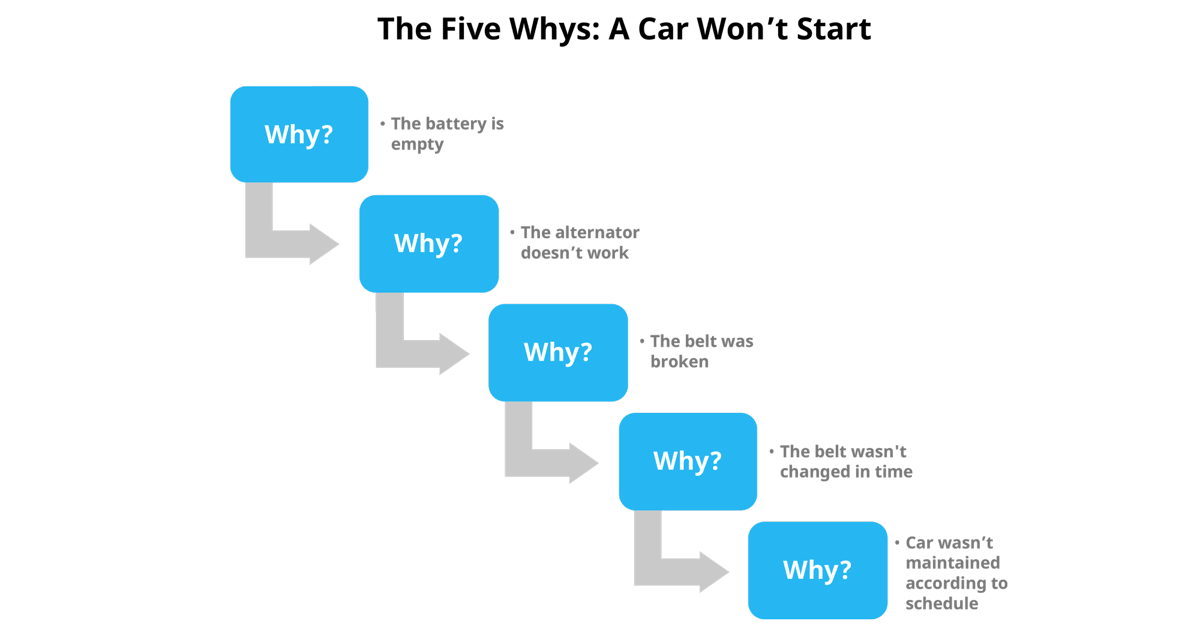 It’s super simple, but effective. Whenever you spot an issue, you just ask why five times in a row, regardless of what the answer to the previous one was. Once you’re done, you’ve almost always identified the real root cause.
It’s super simple, but effective. Whenever you spot an issue, you just ask why five times in a row, regardless of what the answer to the previous one was. Once you’re done, you’ve almost always identified the real root cause.
For continuous improvement, this is especially important, because many of the issues, ideas or suggestions on your backlog might in reality be caused by the same root cause, in which case you can get much better results much faster and cheaper by addressing the root cause, and not the symptoms. So, try to make the use of this framework a habit.
Just as an additional tip, you might often want to do this silently in your own mind since if you ask five whys whenever a colleague says something, they might get a bit annoyed, and you might not exactly make a lot of new friends 😉.
5Ss
The 5S framework is another method that you might use to identify improvements in a workplace. As with many of the other practices we’ve listed, this also has its roots in enabling Just-in-Time manufacturing in Japan, with each of the five actions being represented with a word that starts with an S. The same applies for the English translations as well.
These are, in order:
- Sort
- Set in order
- Shine
- Standardize
- Self-discipline (sustain)
As you may realize from the terms themselves, the 5Ss framework is designed first and foremost for physical workplaces, such as factory floors, but the same principles still hold true in the modern workplace, which is often part physical and part virtual.
The key idea is to focus on making the workplace clean and orderly. In practice, that means eliminating everything that isn’t necessary, making sure that everything is laid out clearly and is well-maintained, that all practices are standardized and that employees are taught to sustain the practices themselves.
We won’t go into detail on what each of the steps involves, so if you’re interested in learning more, I’d recommend visiting the link above.
Digital CI tools
As we’ve already discussed earlier in Kaizen Corner, digital tools can create a lot of value for doing continuous improvement, as many of our customers have seen.
Not only can the right tool make it easier for people to participate – and for the company to collect, manage and prioritize ideas, problems, and improvement suggestions – but it can also remove a lot of the manual work involved in the process, provide analytics and insights into the process right out of the box, as well as increase transparency and communication, all of which together helps create the right kind of a culture within the organization. What’s more, with the right set of tools, you can extend continuous improvement beyond your employees towards your customers, partners and other stakeholders as well, all of which are important sources of insight and improvement suggestions.
What’s more, with the right set of tools, you can extend continuous improvement beyond your employees towards your customers, partners and other stakeholders as well, all of which are important sources of insight and improvement suggestions.
Shameless plug, but if you’d like to give this a try, you can sign up for Viima and use it for continuous improvement with all of your employees – completely for free and for as long as you’d like to.
Key challenges in Continuous Improvement
Before we wrap up this quite an extensive guide to continuous improvement, it’s still important to cover what the key challenges related to continuous improvement are likely to be, and where you might go wrong so that you don’t have the make some of the more common mistakes.
Not having the resources and the commitment for implementation
The first, and probably most common mistake is to just get excited about continuous improvement, ask everyone for their ideas, and then realize that there’s a lot that would need to be worked on, but you don’t have the resources to really implement any of them.
And if you don’t implement the ideas or fix the problems, nothing obviously happens. So, if you’re thinking of doing continuous improvement at the scale of the entire organization, make sure management is onboard and committed to the process, and that you really have enough resources across the organization to implement many of the suggestions that are created.
If you’d just like to start doing continuous improvement in your own team or unit, then the same principles still very much apply, except now you only need approval within your team, instead of having to get the entire top management behind the initiative. This is why we often recommend starting small and proving the value of continuous improvement before scaling the effort to be companywide.
Unclear roles and responsibilities
Another classic challenge comes from having unclear roles and responsibilities. If you don’t have a clear process where people know their own role, and are committed to manage their responsibilities, it’s quite likely that you’ll start to see quite a lot of ideas fall between the cracks, and that again leads to no tangible results, but also frustrated employees.
What we usually recommend is to agree in advance of the initiative on who is responsible and for what. This includes obviously different kinds of ideas, their evaluation and decision-making related to them, but also communication and community management.
This is super simple to do, and it can you save you from a lot of trouble and frustration down the road.
Too slow feedback cycle
As we discussed above, continuous improvement is an iterative process. So, as you keep making improvements all the time, the more of them you can make in the same amount of time, the better the results will usually be.
The technical term for this is throughput, and you can generally improve it by adding resources, and by parallelizing the work so that more people are working on improvements at any given time.
However, an even bigger issue for most organizations is the cycle time of the process. This is the time it takes for an improvement suggestion to actually be implemented. The faster your cycle time is, the more throughput you can also achieve.
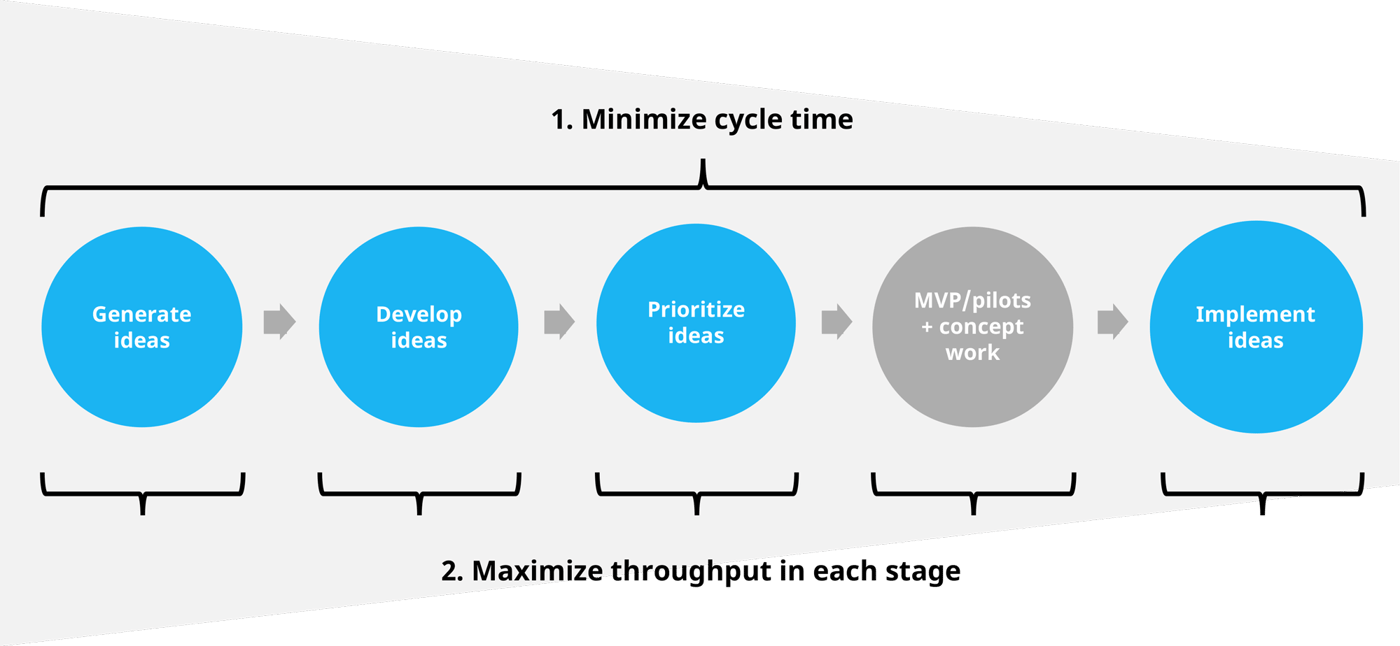
However, an even more important thing to realize is that it’s only after you’ve implemented the improvement, that you can start to analyze the results and learn from them. And, as we’ve learned, the first version of any improvement is with very few exceptions, quite far from the best possible version of it.
So, the faster your cycle time, the quicker you learn, and the quicker you can thus make further improvements, which again fuels the cycle of improvement.
On the other hand, if it for example takes forever to get decisions made, or if one person is a bottleneck for implementation, your continuous improvement results may get crippled.
So, pay special attention to the average cycle times of your process!
Not including all employees in the process
As you might have figure by now, it’s impossible to know where the best ideas might come from in advance. So, if you decide to exclude some people from the process, you might lose ideas worth millions without having the faintest clue of that being the case.
What often makes the situation worse is that the people who get excluded are typically those on the frontlines of the company, and at least in our experience, that’s where the vast majority of good ideas and improvement suggestions (that haven’t already been implemented) come from, and the reason for that is also pretty natural: if management is aware of a significant issue, they will probably address it, and the further away the management is from an issue, the less likely it is to know of it.
With modern technology, it’s quick, easy, and cheap to include everyone in the process, so there really shouldn’t be any excuses for not including them.
Plus, by engaging everyone in the process, you show that you care about people’s insights and expertise and can shape a more proactive and engaged culture.
Continuous Improvement Best Practices
To wrap up this article, we have a few concrete recommendations and best practices for those of you who are looking to either get started with continuous improvement, or that are looking to get better at it.
There are obviously many things you could do to try to achieve that, so we've focused on just the few that are very practical and relevant for everyone regardless of how advanced you are, what you're looking to achieve with continuous improvement, or what your industry is.
Embed CI in daily processes
The first, and perhaps the most important point is to make sure that continuous improvement really is a part of people’s everyday job.
If you’re looking to create a culture of continuous improvement and excellence, you really need to make sure that it isn’t something you do every now and then, but that people really take it seriously and either fix or report issues and opportunities for improvement proactively whenever they spot them. There are of course many ways you can try to achieve that, for example with concrete rewards and recognition, but the one that we’ve found to be the most effective is to just make it part of your daily, or at the minimum weekly processes.
There are of course many ways you can try to achieve that, for example with concrete rewards and recognition, but the one that we’ve found to be the most effective is to just make it part of your daily, or at the minimum weekly processes.
For example, if you have a weekly team meeting, have everyone report at least one improvement (no matter how small) they’ve identified, and another that they’ve also implemented every week in front of the entire team. By doing that, you not just communicate the importance of continuous improvement, but also put a forcing function for getting started, and once people realize how beneficial it is, they will start to love the feeling of constantly getting better and getting recognition from their peers.
Coach & educate employees on what to look for
As we've covered earlier in the article, employees play an extremely important part in getting results with continuous improvement. You can't just manage it entirely top-down, you do really need to get everyone involved.
However, most employees might not be very familiar with continuous improvement, so whenever you get started with it, make sure you teach the basics of the concept, but more importantly, what it is that they should really be looking for.
It usually makes sense to both look for very tangible problems or issues, but also areas where there’s clearly room for improvement, even if there isn’t a problem per se.
The best ways for doing this vary quite a bit depending on the type of business you’re in, but generally there are a couple of common categories for this:
- Repetitive problems or requests from customers (“I wish you had…”)
- Different kinds of inefficiencies:
- Waste material or products
- Time spent waiting for something or someone (utilization rate)
- Quality issues such as irregularities or exceptions
- Poor planning or overburdening of either people or machines
By just having a super simple checklist like this to remind people of the most common sources of improvement suggestions, you can easily help them focus on whatever it is that matters the most for your business, and once they understand the role this can play in helping the company, and thus themselves, succeed, getting employees engaged is very rarely a challenge.
To help you get started, we’ve put all this information into a convenient presentation, together with a number of practical tools, templates, and examples that you can use to drive results within your organization and understand how it works in practice. You can download it from here.
Continuously improve your continuous improvement process
You probably saw this one coming, didn’t you?
Continuous improvement is all about committing to the systematic pursuit of excellence, and not being satisfied with the status quo. While that’s obviously true for your products, services, and processes, it’s very much the case for your continuous improvement processes as well!
So, monitor your CI processes closely, track your throughput and your cycle times, as well as the value you’re creating with the process, and make sure that you’re always moving in the right direction.
Conclusion
In some industries, people are often fanatical about continuous improvement and lean, and for the most part, for good reason.
Continuous improvement is what really enables a company to achieve operational excellence, but it’s also super important for those pursuing innovation and for those looking to create or scale new businesses. In other words, it’s important for every organization that is looking to do better.
So, if you don’t already have a systematic process in place for continuous improvement, I’d highly recommend getting started!
Every continuous improvement program needs the input of employees and Viima can support your needs, every step of the way, from idea collection to implementation. See it in action. Book a demo!






